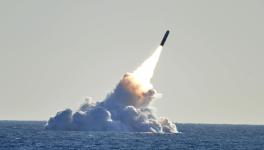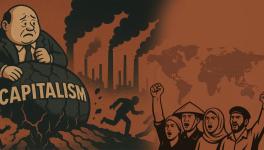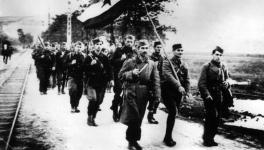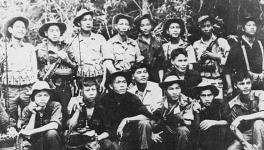Defeat of Fascism in 1945: Historical Lessons, Contemporary Relevance

Mainstream imperialist narratives often obscure critical truths about the origins, conduct, and implications of the Second World War. It is necessary to reiterate the revolutionary implications of the victory over fascism by challenging the pro-imperialist distortions of history in order to lay a basis for the struggle against neo-fascism today.
These distortions of history emerged after 1945 when Nazi German generals and "in-house" historians, under the patronage of US monopoly capital and their government, began to publish memoirs and studies which sought to view the course of the Second World War through the exclusive use of sources from the US, German, and other West European countries.
These Nazi German Generals also sought to falsely claim that the Nazi German Wehrmacht were professional soldiers and they had no role in the Nazi genocide in the Soviet Union and Eastern Europe.
This bias has been amplified by the output of Hollywood and its derivatives. This distortion of history is most acute as regards the role of the Soviet Union in the defeat of fascism. However, the work of historians, such as David Glantz, Omer Bartov, David Stahel and Wendy Goldman (to mention some historians whose scholarly output is published in English), has worked to correct much of these historical distortions.
Origins of the Second World War
The Second World War did not begin in 1939 with Hitler’s invasion of Poland, but in 1931 with fascist Japan’s invasion of Manchuria in China, a brutal campaign mirroring European colonial genocide in North and South America, Asia, and Africa. Japan’s aggression was an outcome of inter-imperialist rivalry that initially resulted in the Great Depression. Japan, like the rest of the metropolis, emerged from the Great Depression through its military build-up. This inter-imperialist rivalry that triggered Japan's invasion of China was also a militaristic response to the economic blockade that US monopoly capital and their government sought to impose on fascist Japan.
The ruling Kuomintang headed by Chiang Kai-shek in China, however, prioritised the civil war against the Communist Party of China (CPC) and did not accord primacy to the resistance against the occupation of parts of China by Japan. This resulted in the Xi'an incident in 1936 whereby Chiang Kai-shek was compelled by his own generals to form the Second United Front with the CPC to jointly resist the occupation of parts of China by Japan.
Meanwhile, the fascist takeover in Germany in 1933 was broadly the joint outcome of: first, the economic crisis that manifested in Germany due to its transformation, after its defeat in the First World War, into a near-client state of rival imperialist powers including US monopoly capital; second, the willingness of German monopoly capital to place all their eggs in Hitler's basket to ward off the threat that they faced from the Communist Party of Germany and the Left more broadly; third, the tragic disunity between the Communist Party of Germany and the Social-Democratic Party of Germany.
Nazi Germany's military build-up since 1933 began to metastasize into conquest and war. But French and British monopoly capitals and their governments refused to ally with the Soviet Union, prioritising anti-communism over collective security against fascist aggression.
Their “appeasement” of Hitler—exemplified by the Munich Pact of 1938—emboldened Nazi Germany. Thereby they hoped to direct Hitler eastward toward the Soviet Union. Faced with this betrayal, the Soviet Union, in a reprise of the Brest-Litovsk Treaty of 1918, sought to secure itself (albeit temporarily) through non-aggression pacts with Nazi Germany in 1939 and with Fascist Japan in 1940.
Japan was no doubt influenced to sign this pact in 1941 due to its defeat in the battles in and around Khalkhin Gol in the late 1930s at the hands of the Soviet Union and Mongolia.
Nazi Aggression Till June 1941
Hitler surmised, not incorrectly, that Western Europe was a weaker opponent when compared to the Soviet Union. Therefore, Nazi Germany attacked these countries. This invasion began with the swift defeat of Poland, which also involved the reintegration of its eastern parts with the Soviet Union, which had been captured by Poland in 1920.
This was followed after a few months by a rapid defeat of the French armed forces by Nazi Germany in 1940. But Hitler "inexplicably" allowed the British expeditionary forces to escape from Dunkirk by sea. The expectation behind this decision was the hope that some modus vivendi could be reached between Germany and Great Britain. But this did not transpire. Moreover, the air war that followed between Britain and Germany remained inconclusive.
The Nazi occupation of Western Europe and countries to its east revealed a key difference whereby the war to the west of Nazi Germany was inter-imperialist ("civilised") while the war to the east of Germany was genocidal settler colonialism, reminiscent of what transpired in the US against Native Americans, African Americans, and the land-grabs from Mexico.
However, the communist forces and their fellow travellers were in the forefront of the anti-fascist resistance, especially in France, Italy, Yugoslavia, Greece, Albania, Romania, Bulgaria, etc. These anti-fascist resistance efforts contrasted sharply with the collaborationist tendencies of Right-wing forces with Nazi occupation in many countries of Europe.
Nazi Germany's War of Extermination Against Soviet Union
Hitler’s decision to invade the Soviet Union in 1941, before defeating or settling with Britain, was a strategic error. Driven by a settler colonial vision that derived from the experience of the US, the Nazi regime sought to exterminate or enslave the Soviet people. Communists and Jews were synonymous to Nazis. Therefore, Germany visualised this invasion as a means to get rid of the ostensible Jewish-Bolshevist threat to Europe.
At least some Nazi German generals in 1940 were apprehensive of the outcome of the invasion of Western Europe. But the rapid fall of Western Europe induced a change in their thinking. Therefore, when Hitler decided to invade the Soviet Union soon after, the Nazi German generals supported this decision.
The entire invasion plan seems to have been based on the expectation that there would be a rapid political collapse in the Soviet Union that would result in its defeat. In 1941, the ruling monopoly capitalist circles of both the US and Britain also expected the Soviet Union to collapse in short order. But unlike the other armies of Europe, the Soviet Red Army mounted a strong defence, as was noted by Nazi German generals too.
However, mainstream propaganda after 1945 has sought to attribute Soviet victory solely to the harsh climate and geography and Soviet superiority in military and economic mass. If harsh climate and geography were the sole or primary determinants of the Soviet Union's victory over Nazi Germany, then Tsarist Russia would not have been defeated by Imperial Germany in the First World War.
Further, in the early period of the Nazi invasion of the Soviet Union, the Nazi German forces enjoyed numerical superiority in military personnel.
Socialist Mobilisation & Red Army's Resistance
The Soviet Union’s victory was not foregone but the product of unprecedented popular mobilisation operating within the framework of a centrally planned socialist economy which enabled the previously mentioned resistance of the Soviet Red Army. Many factories relocated eastward and produced tanks, artillery, planes, etc. Moreover, the share of defence production in output increased to levels that were historically unprecedented and far surpassed what was the case in the US, Germany, Japan, and Britain.
The popular mobilisation in the Soviet Union involved enormous collective sacrifice both in terms of military mobilisation and collective labour. Military mobilisation disproportionately involved men, but women too were mobilised in the Red Army to an extent that vastly exceeded what was the case in the armed forces of other countries involved in the Second World War. Women, senior citizens, and teenagers were disproportionately mobilised to work in industries and farms.
Once the war between Nazi Germany and the Soviet Union became an industrial war, the ability of the socialist system to more effectively mobilise resources and motivate popular participation in the war effort sealed the fate of Germany. Assistance provided by the US (and Britain to a lesser extent) to the Soviet Union was useful but was not timely or significant enough to be the decisive factor in the victory of the Soviet Union over Germany. Therefore, the ramp-up in war production by Germany in the second phase of the war in Europe, through the use of explicit industrial policy and slave labour, could not change the outcome of the war.
War Begins in the Pacific Theatre
Meanwhile, there was a debate in the ruling circles of Fascist Japan in 1941 about the next move to be made in the Second World War. While the majority of Japanese generals favoured an attack on the US Navy in the Pacific followed by an invasion of Southeast Asia and other islands in the Pacific Ocean, a minority favoured an attack on the Soviet Union. Japan decided to attack the US navy in the Pacific.
Any possibility of Japan joining the Nazi German invasion of the Soviet Union was negated by Germany's first decisive defeat in the Battle of Moscow in December 1941, which segued into a successful winter counter-offensive that lasted till early 1942.
In December 1941, Japan attacked and largely destroyed the US naval base in Pearl Harbor. This marked the formal entry of the US into the Second World War. Japan rapidly attacked and captured a number of French and British colonies in Southeast Asia and some islands in the Pacific Ocean.
Both in East Asia and Southeast Asia, the resistance to occupation by Japan was principally led by communist forces and their fellow travellers. Hitler declared war against the US in December 1941 even though Japan did not enter into a war against the Soviet Union.
Meanwhile, the first phase of the war in the Pacific theatre was principally a naval-cum-aerial engagement in and around various islands. The clear industrial superiority of the US began to manifest itself both in the naval realm in the Pacific theatre and in the carpet bombing of Germany and Japan.
While this carpet bombing did adversely impact industrial production in both countries, the deliberate targeting of civilians did extract a heavy death toll. But the carpet bombing did not significantly lead to a decline in morale either in Germany or Japan.
Three Decisive Battles -- Leningrad, Stalingrad, Kursk
Along with the Battle of Moscow, another important centre of Soviet resistance to Nazi German aggression was in the Battle of Leningrad. Beginning in 1941, the near-total siege of Leningrad put in place by Nazi German forces with the ultimate intention of razing the city to the ground, resulted in the deaths of millions of people due to attacks and starvation, but the Soviet defenders fought on. The Battle of Leningrad was finally won in 1943-44. Pro-imperialist narratives tend to characterise this as merely the Siege of Leningrad and not the Battle of Leningrad. Thereby, they seek to deny legitimate agency to the Soviet defenders of Leningrad.
After its defeat in the Battle of Moscow in late 1941, the Nazi German forces in the summer of 1942 prioritised their military offensive in southern Russia with the intention of seizing Soviet oil fields in the Caucasus and capturing Stalingrad to try and disrupt the use of the Volga river as a vital transport corridor by the Soviet Union.
The Red Army fell back to Stalingrad but mounted a strong defence of the city. Likewise, the ingress of the German armed forces into the Caucasus remained incomplete due to Soviet resistance. The Battle of Stalingrad was the turning point in the Second World War.
The German Sixth Army and the personnel of other Axis powers, such as Romania, were surrounded by the counter-offensive of the Red Army in late 1942. By early 1943, the remnants of the trapped Nazi German forces surrendered. This massive defeat of Germany at the hands of the Soviet Union turned the tide of the Second World War in Europe. Not only did the morale of the anti-fascist forces increase after the Battle of Stalingrad, but it increasingly became evident to German monopoly capital that Nazi Germany was doomed.
The next decisive battle between Nazi Germany and the Soviet Union was at Kursk, which involved the largest tank engagements in world military history. After their defeat in the Battle of Kursk, the German forces were compelled to permanently shift to the strategic defensive in their war against the Soviet Union.
Meanwhile, the final defeat of Nazi German forces in North Africa in 1943 was followed in a few months by the liberation of Sicily by the armed forces of the US and Britain. This segued into the beginning of the liberation of southern Italy by the end of 1943. As the liberation of Italy proceeded, the fascist leader of Italy, Mussolini, was ousted by other elements in the ruling circles of the fascist elite. But Nazi German military intervention restored Mussolini as ruler of a client state in northern Italy till 1945.
It is arguable that monopoly capitals of the US and Britain and their governments delayed the direct opening of the second front against Nazi Germany till 1944 by focusing on North Africa and southern Italy. This delay was possibly motivated by the following consideration: such a delay, it was expected, would relatively weaken both the Soviet Union and Nazi Germany.
The relative weakening of the Soviet Union would be useful to US monopoly capital after the end of the Second World War, while the relative weakening of Nazi Germany would ensure that the resources required for the eventual launching of the second front would be lower than otherwise.
The Defeat of Nazi Germany
The Second Front in Western Europe through the liberation of Normandy in France, which began in June 1944, and the liberation of Byelorussia/Belarus by the Red Army began merely days apart. Germany was unable to deal with this double blow, and its occupation of Europe began to crumble at both ends. Not unexpectedly, there was an assassination attempt on Hitler by sections of the armed forces of Germany in late July 1944, but he survived it.
But the end of Nazi Germany was merely months away. The Nazi German leadership began to prepare for the "day after" by liquidating those top leaders of the Communist Party of Germany, such as Ernst Thalmann, whom it had imprisoned.
Thereafter, the Soviet Red Army began to liberate Eastern Europe while the US and British forces began to liberate Western Europe. However, the further course of the war in Western Europe and Eastern Europe began to diverge, especially when the defeat of Nazi Germany became ever more certain in early 1945.
In Eastern Europe, the Nazi German forces fought bitterly, but when defeat was nigh, they quickly fled west whenever possible and surrendered to US and British armed forces. While in Western Europe, the German forces put up less of a fight and surrendered relatively easily. In other words, there was an eerie analogy regarding the divergence between the fighting in Western Europe and Eastern Europe in the initial (1939-42) and closing (1944-45) phases of the Second World War in Europe.
The reasons for this divergence are not too involved to discern. As previously argued, the war in Western Europe was an inter-imperialist war while the war in Eastern Europe was a settler colonial war of extermination by Nazi Germany.
Therefore, soldiers in the French Army from Africa were massacred by the forces of Nazi Germany in 1940, but the treatment of white West European soldiers by both sides was largely "civilised."
However, a few Nazi Germany units replicated their criminal actions meant only for Eastern Europe and the Soviet Union in Western Europe. But such instances were few and far between. It was in such idyllic circumstances that the reforging of the unity of Western Civilisation (under US imperialist hegemony) was initiated.
Nazi Germany surrendered unconditionally in May 1945 soon after Berlin had been liberated by the Red Army. By 1945, the Red Army was responsible for the destruction of up to 80% of Nazi Germany's military personnel, a contribution obscured by imperialist narratives that exaggerate the significance of US interventions in Europe.
Surrender of Fascist Japan
Meanwhile, fascist Japan was facing reverses on all fronts in the Pacific theatre. First, it was decisively defeated by the US in a series of naval battles by the end of 1944 and the beginning of 1945. Second, the dogged resistance in China and other parts of East Asia and Southeast Asia against Japanese occupation was straining its resources.
Third, US carpet bombing had reduced much of urban Japan to rubble with the exception of Kyoto. In fact, the carpet bombing of Tokyo in January 1945 extracted a higher death toll compared with any other single air raid, including the nuclear bombings of two cities in Japan in August 1945. The sparing of Kyoto was an initial overture of US monopoly capital in achieving its imperialist hegemony over Japanese monopoly capital.
According to previously set out agreements between the US, Soviet Union, and Britain, the Soviet Union began its military offensive against fascist Japan in early August 1945, which liberated Manchuria, northern Korea, and islands north of the Japanese mainland. Anticipating the likelihood of Soviet ingress into mainland Japan, the US dropped nuclear fission bombs on Hiroshima and Nagasaki a couple of days earlier. The nuclear bombing of Japan was also a demonstration of the military superiority in the nuclear domain of the US vis-à-vis the Soviet Union. However, the Soviet Union achieved nuclear parity by 1949.
But Japan did not surrender till a few days later when it became evident that it faced a two-front war against the US and the Soviet Union that not only meant certain defeat but there could emerge a threat to the domestic hegemony of Japanese monopoly capital due to Soviet ingress into mainland Japan (as was the case in Korea).
Pro-imperialist propaganda seeks to obscure these complex political economy considerations by spreading the myth that the nuclear bombing of Japan by the US was meant to prevent further large-scale deaths in the Pacific theatre. It is noteworthy that since 1945, no one else has had the ideological privilege of reducing its military casualties by using nuclear weapons against its opponents.
Historic Defeat of Fascism and After
The defeat of Nazi Germany and Fascist Japan (and their Axis fellow travellers) liberated Eurasia and Africa from the threat of fascist genocide. The death toll in the Second World War was in excess of 60 million, and more than two-thirds of these fatalities were borne by the Soviet Union and China. The defeat of Nazi Germany and Fascist Japan converted them into client states of US monopoly capital.
But in large parts of Asia and Africa, this meant the return of colonial rule by the imperialist powers. However, British and French monopoly capitals were weakened by the Second World War and attained near-client status of US monopoly capital, more so in the case of Britain ("special relationship").
Consequently, the British and French colonial empires began to disintegrate as national liberation movements surged all over Asia and Africa with the support of the Soviet Union. US monopoly capital, as part of its efforts to establish its imperialist hegemony, sought to engage in a twin manoeuvre to try and deal with political decolonisation.
First, try and ensure that communist forces or their fellow travellers were not in the leadership of these national liberation movements through military interventions, coups, and assassinations. Most capitalist and proto-capitalist forces in these colonies and ex-colonies, therefore, accepted their secondary status under US imperialist hegemony since the alternative could be socialism, as evidenced by the experience of China, Vietnam, North Korea, Eastern Europe, etc.
In a handful of countries, such as India and Indonesia (till 1965), the domestically hegemonic monopoly capitalists sought to manoeuvre between the US and the Soviet Union in order to extract concessions from both under the rubric of non-alignment. But the souring of the hopes of comprehensive national liberation under the aegis of dirigisme, that spanned both the political and economic domains, was to be expected due to the inability of the capitalist classes in these countries to fundamentally break with metropolitan capital. This was the case because that could have undermined their domestic hegemony.
Fascist regimes emerged in Indonesia in 1965 and in Chile in 1973 after the US-sponsored military coups and massacres of communists and their fellow travellers in both countries.
Second, US monopoly capital and its government sought to militarily encircle the Soviet Union and China and strategically isolate them. This was part of the US imperialist strategy to keep Eurasia divided by supporting a network of client states ("allies").
The establishment of the settler colonial Zionist state of Israel in historic Palestine was part of this overall strategy, but ideologically fortified by the harvesting of European "guilt" for the Holocaust (but not for the remaining components of Nazi genocide).
Selective Ideological Rehabilitation of Fascism
Those who argue to the contrary that US monopoly capital is directly or indirectly ideologically beholden to Zionism are unable to account for the following two facts. First, the absolving, by US monopoly capital, of the principal perpetrators of the Nazi genocide, including the Holocaust, except Nazi ringleaders and a couple of Nazi German generals who were irredeemably close to Hitler. Those absolved include Nazi German monopoly capitalists, almost all generals of Nazi Germany, and most of its bureaucrats.
Second, the studied cultivation of client states in Eastern Europe after 1989 by US monopoly capital who continue to derive their ideological legitimacy from their fascist history and collaboration with the Nazi genocide, including the Holocaust in Europe.
Imperialist ideologues in the US and Europe provide the ideological manure for this manoeuvring by establishing a false equivalence between Nazi Germany and the Soviet Union.
Thereby, mainstream propaganda after 1945, led by US monopoly capital, their government, and their client states and organisations have sought to de-hyphenate the Nazi genocide in Eastern Europe (Jewish-Bolshevik) and exclusive attention was ahistorically focused on the Holocaust.
This inter alia served to obscure the political economy of Nazi Genocide which was fundamentally anti-communist in its settler colonialism. This mainstream propaganda also conceals the collaborative role of Right-wing forces in Eastern Europe and the Soviet Union, especially in Latvia, Lithuania, Estonia, Western Ukraine, Slovakia, Romania, Hungary, and Croatia in the Nazi Genocide. The first de-hyphenation also works to negate the possibility of comparative evaluation of the Nazi genocide and colonial genocides in the Global South.
In this regard, one notable example may be highlighted: the rations allotted to Indians in famine "relief" food-for-work programmes in colonial India by the British Indian government were lower than that allotted to prisoners in the Buchenwald concentration camp by the Nazis. The British Indian colonial government's commitment to Social Darwinism was a historical progenitor of Nazi Germany's genocide in Europe.
In this imperialist narrative, the Commissar Order of Nazi Germany, whereby communist political officers in the Soviet Red Army were subject to immediate liquidation, and the Nazi German General Plan East to exterminate tens of millions of Soviet people and East European people through execution, famine, and slavery (that was partly successful) have sought to be excised from or downgraded in the historical record.
After 1991, Russian monopoly capital too has sought to de-hyphenate Soviet socialism and Russia, and the entire history of Soviet resistance to Nazi Germany has been ideologically reworked as the continuation of a resilient Russian nationalism ostensibly going back a thousand years. This tendency continues to the present.
Likewise, the US decision to allow the continuance of the institution of the Japanese Emperor, albeit with the renouncing of his "divinity," was accompanied by a rehabilitation of the handful of war criminals who were executed but granted special memorials. This was accompanied by a denial of or silence about fascist Japan's genocide in Asia, especially in China.
The exaggeration of the role of the US in the Second World War, denial of or silence about the divergence of the conduct of the Second World War in Western Europe and Eastern Europe, including the Soviet Union, the de-hyphenation of the Nazi anti-Jewish-Bolshevik genocide, the denial of the analogy between the genocides in Europe and the Global South, the de-hyphenation of Soviet and Russian in the anti-fascist resistance, the propagation of the myth about the good Wehrmacht as opposed to the evil organisations of Nazi Germany such as the Schutzstaffel or SS, and the near-wholesale rehabilitation of the leadership of Fascist Japan as embodied by the Japanese Emperor are the principal axes of historical falsification about the defeat of fascism in the Second World War.
This rewriting of history of the defeat of fascism in the Second World War has played a key ideological role in the still ongoing efforts to manufacture consent for US imperialist hegemony.
The Rise of Neo-Fascism
After 1945, the existence of the Soviet Union and the socialist system, among other things, compelled capitalists in all countries to make varying degrees of concessions to the working people, which resulted in the establishment of a social welfare system that fell short of what was achieved in the socialist countries. But it was historically unprecedented as far as the capitalist system was concerned.
In this light, the competition between the capitalist system under the aegis of US imperialist hegemony and the socialist system led to the achievement of near-full employment in most economies of the metropolis and economic growth in the Global South that was markedly superior to what was the case in the colonial period.
However, the incompatibility of persistent near-full employment with price stability in the capitalist system inaugurated the transition to the neoliberal stage of the capitalist system, which involves an attempt by metropolitan capital to restore price stability by increasing unemployment and precarity all over the world. Neoliberalism was characterised by the rise to dominance of international finance capital centred in the US that gave effect to this heightened unemployment and precarity.
However, this did not lead to a crisis of legitimacy for the capitalist system because of weaknesses in the socialist system. On the one hand, the split between the Soviet Union and China fortified US imperialist hegemony. On the other hand, this split did not allow the political economy space for the socialist system to overcome the political crisis it was facing.
The political crisis facing the socialist system was the demobilisation of the working people due to their being unable to fully participate democratically in political and economic decision-making. Thereby they mostly became passive recipients of welfare in the socialist system and passive onlookers to the political decline of the socialist system.
The consequent political extinguishment of socialist experiments in Eastern Europe and elsewhere, which culminated in the dissolution of the Soviet Union in 1991, prevented the capitalist system from being afflicted with the crisis of legitimacy when it transitioned to its neoliberal stage. The dissolution of the Soviet Union also led to the solidification of US imperialist hegemony.
In these circumstances, those socialist countries that survived beyond 1991 were compelled to recalibrate their engagement with metropolitan capital, which may therefore be seen as the fourth iteration of Brest-Litovsk after 1918, 1939, and 1941.
But neoliberalism, which privileges the attainment of price stability through the furthering of unemployment and precarity, has unleashed a different crisis. This crisis of overproduction emerges in the neoliberal stage of the capitalist system due to a squeeze on the share of wages globally. To try and prevent this crisis of neoliberalism from undermining its legitimacy, monopoly capital seeks to cultivate neo-fascist forces.
The emergence of neo-fascism also involves the intensification of the differential squeeze on different segments of the working people, both domestically and globally, to try and ward off this crisis of legitimacy. But this is unlikely to provide a durable fix since there are definite limits to the extent to which a differential squeeze could be applied without both intensifying the crisis of overproduction and reigniting a legitimacy crisis for the capitalist system.
Conclusion
The rewriting of the history of the defeat of fascism in the Second World War under the aegis of US imperialist hegemony makes the ideological terrain conducive for the growth of neo-fascism.
The development of a scientific understanding of the defeat of fascism in 1945 and the lessons from the historical experience thereafter provide the means to develop political-organisational tools to confront contemporary neo-fascism. But this confrontation cannot be confined to the terrain defined by the apparent conflict between neo-fascism and cosmopolitan neoliberalism since both involve ideologically divergent ways of continuing subservience to metropolitan capital.
Meaningful resistance to neo-fascism has to, therefore, involve a fundamental break with the entirety of the neoliberal project. This fundamental break logically calls for a need to rework the contours of the socialist alternative. But this reworking must learn from its past iterations by centring its political energies on the democratic empowerment of the working people through an unleashing of revolutionary agency that is grounded in concrete historical circumstances of revolutionary struggle and solidarity.
C Saratchand is Professor, Department of Economics, Satyawati College, University of Delhi. The views are personal.
Get the latest reports & analysis with people's perspective on Protests, movements & deep analytical videos, discussions of the current affairs in your Telegram app. Subscribe to NewsClick's Telegram channel & get Real-Time updates on stories, as they get published on our website.
























